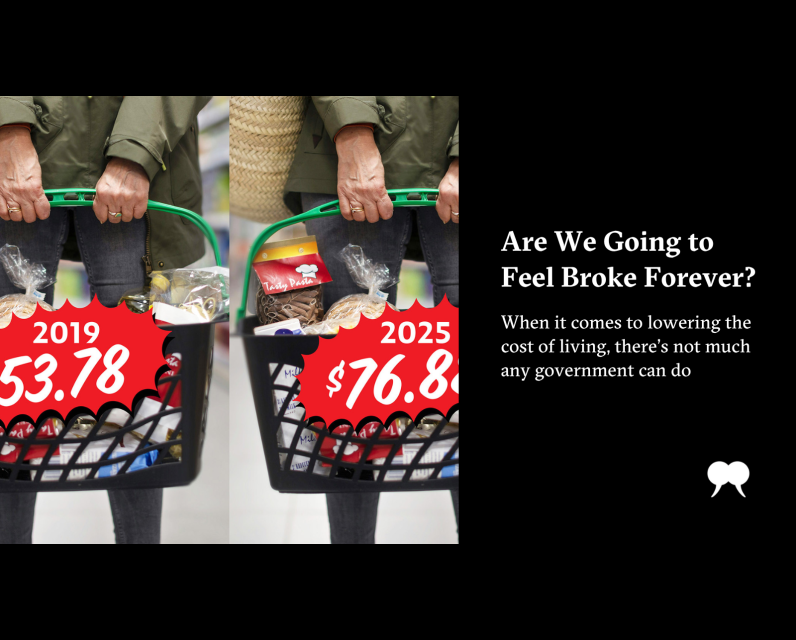Stay informed
Are We Going to Feel Broke Forever?

It’s safe to say a lot of Canadians are feeling lousy about their ability to make ends meet. A recent Royal Bank of Canada survey found that nearly half of respondents say they can’t maintain their standard of living, while an October poll from Abacus Data found that 62 percent of respondents cited the rising cost of living as one of their top concerns.
In other words, little has changed since the spring, when the major parties’ federal election campaigns burst with pledges to make life more affordable for Canadians, including by lowering taxes and building homes (along with parties’ claims that their plans to cut taxes and build homes were better than other parties’ plans to cut taxes and build homes). Granted, long-term change, by definition, takes time. But the general anxiety also reflects a larger tension: affordability, and what it takes to achieve it, doesn’t mean the same thing to everyone.
For economists, affordability is largely a function of wages adjusted to inflation: as long as average wages are high enough for people to pay for what they need, then the cost of living is deemed affordable. One way to gauge that is Statistics Canada’s Consumer Price Index. It offers a snapshot of the prices of a metaphorical basket of eight categories, including food, education, recreation, and shelter—which covers rent, interest on mortgage payments, and even costs such as painting or installing flooring. The CPI has largely decreased over the past three years, a sign that the cost of goods isn’t rising as much as in, say, 2022, when inflation was at its peak. On the surface, then, prices are much more stable than three years ago.
At the same time, wages have generally kept pace: many Canadians are in an equivalent place to where they stood in February 2020, says David Macdonald, a senior economist at the Canadian Centre for Policy Alternatives. (He notes there are exceptions, including some public sector workers whose wages have been frozen.) To economists, he says, inflation is a problem that’s largely been solved. If people have more income, that spells affordability.
But consumers typically don’t see it that way. Most Canadians, says Macdonald, “don’t care about wages, even if they’ve gotten a raise. All they care about is that this bag of chips cost[s] $1 more than two years ago, and this thing of coffee [that] used to cost $10 . . . cost[s] $20.” In other words, for many, what they’re spending matters more than how much they’re making—what’s known as loss aversion. For Macdonald, that makes inflation more of a “political problem” than an economic one. Because while economists are focused on higher wages as the solution to higher costs, it falls on politicians to show how their policies are going to make things cheaper.
It’s not just chips and coffee, of course. For decades, a widely accepted guideline for budgeting was that shelter costs should take up about 30 percent of the basket; in practice, many Canadians typically spend somewhere between 35 and 50 percent of their salary on housing. The cost of rent has outpaced inflation, and demand for housing is pushing up costs. According to Statistics Canada, rents in Vancouver went up about 27 percent between the first quarter of 2019 and the first quarter of 2025; in Montreal, they went up nearly 71 percent during that same period.
Mortgage costs and, to some extent, rent are heavily driven by the central bank, which moves interest rates up or down to keep prices stable. If inflation goes above a target level of 2 percent, it raises rates. When these and, therefore, mortgages go up, “so do rents,” says Macdonald, “because those rents are related to landlords’ mortgage interest costs, and they pass [those] on to tenants.”
So what can governments do? Angella MacEwen, research director at the Canadian Union of Public Employees and a policy research fellow at the Broadbent Institute, says enacting rent control is one way to lower housing costs. While that falls under provincial and territorial jurisdiction, she says the federal government could work with various jurisdictions to create tenancy boards, which would set rental controls and allow renters to report bad landlords.
Macdonald warns that any rent control measures would have to be supported with increases in housing supply, particularly of non-market housing such as co-operatives. The federal government invested in programs to develop housing co-ops from the 1970s up until the early 1990s, with additional provincial funding for programs in British Columbia, Quebec, and Ontario. But in a period of austerity in the 1990s, the federal government stepped away from building, leaving it to private developers in the name of prioritizing efficiency. That may change: through the Build Canada Homes initiative, announced in mid-September, the government has pledged to direct $13 billion initially toward building transitional and supportive housing.
Cutting taxes, the other pillar of election promises, goes only so far on the affordability front. Macdonald says the federal government’s cancellation of the consumer carbon tax would presumably lower prices for gasoline and home heating oil, though the full benefit to consumers may depend on whether fuel companies pass along the savings.
To fund tax reductions, the federal government has to cut services. Public service unions warn that Prime Minister Mark Carney’s proposed 15 percent spending cuts over three years are already leading to job losses and reduced accessibility of services like Employment Insurance or the Canada Revenue Agency. “Now it’s harder for you to get EI because you can’t get through to the call centre,” says MacEwen.
Another consequence of public funding cuts is the creeping privatization of health care services, including certain surgeries, says MacEwen. She points out that these out-of-pocket costs likely cancel out any supposed benefit from tax reductions, as the payment is usually higher than the value of the cut.
In early October, Carney announced that a federally funded school food program would be made permanent, and introduced automatic tax filing for low-income Canadians, ensuring they can access government rebates and programs like the GST rebate.
Macdonald points out that the school food program already existed and was funded to 2029, meaning that the announcement has little short-term impact on the program. Given what services might be lost when the government announces its austerity budget, “this is a drop in the bucket.”
Both experts say there are better means of tackling affordability than slashing taxes. Measures such as subsidizing child care fees, dental care, and pharmacare make a difference. There may be little the government can do about the cost of groceries, however. Macdonald points out that grocery store margins, while relatively low, have “doubled roughly since pre-pandemic times, and they’ve stayed there.” Though some argue that’s a result of the dominance of large grocery chains, more competition probably wouldn’t change much, he says. Since profit margins are so tight, even when they double, the effect on consumers is still small, whereas bigger price increases come from upstream forces such as energy companies raising transportation costs and reaping the benefits: “There’s a big supply chain that happens before you end up in the grocery store buying that potato.”
There are sectors where more competition could help. MacEwen cites Sasktel, a Crown corporation and public utility, as an example of how public communication services can lower costs. “Cellphone bills are half the price in Saskatchewan than everywhere else because there’s a public option,” she says. It doesn’t have to dominate the market, but it can “just exist to keep private companies from profiteering and to offer a more affordable alternative.”
But MacEwen doesn’t see that idea taking hold elsewhere. “I don’t think any of our current elected leaders are leaning that way,” she says. “What we’ve seen is that they really want to offer incentives to the private sector. They want to privatize things. They want to make it somebody else’s problem.”
There are ways the government could more directly support lower-income families. Macdonald raises Mexico’s canasta básica, or basic food basket, as an example: it contains twenty-four pantry items considered essential for providing nutrition and hygiene for Mexican families, including bread and tomatoes, and costs nearly $70 in total, paid by the family, with a commitment by the government to keep prices the same, despite inflationary pressure. The basket was introduced in 2022 and has been renewed for 2025. “You’re not getting the most premium bread,” says Macdonald, but the idea is to regulate the prices of specific items to ensure that most families can afford them.
Aside from serving as a case study, that example helps illustrate the underlying problem of perception: while economists might be calculating a metaphorical basket of goods, consumers are buying actual baskets of goods. The bottom line for many remains the same—those goods are more expensive than they were a few years ago, and the costs aren’t going to go back to pre-pandemic levels. And when people are angry about high prices, says Macdonald, “they’re going to take it out on the government in power.”
The post Are We Going to Feel Broke Forever? first appeared on The Walrus.

Comments
Be the first to comment